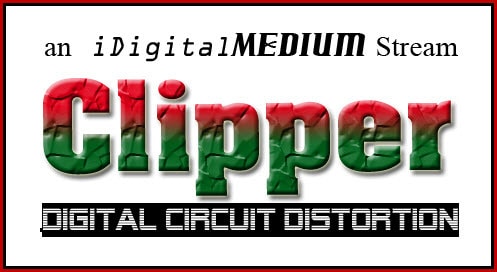Stream 3 – “Clipper” aka Digital Circuit Distortion
(Spiricom Edition)
Since 12/1/2016
Try out our new audio only stream, fondly named “Clipper”!
NO Radio, NO Human Voice, NO External Input are used in the production of this live stream. An audio file IS used in this live stream. (detailed information below)
*All iDigitalMedium streams are certified 100% LIVE. Nothing is pre-recorded unless explicitly stated. If an audio file or sound source is used, the original will always be provided on that stream page.
Click on PLAY button above
If Google Chrome stops playing, click play again or use another browser
Player not working? Try one of these other solutions:
Direct Link: http://cent6.directhostingcenter.com:2199/start/ggfcsisf/




History
In the fall of 2016 an accidental discovery was made. When audio run through a program called VSTHost was over-amplified (volume was raised too high) it seemed to have an unexpected effect….Voices. Not that much attention was paid to it at the time, why would anyone over-amplify sound to the point of distortion anyway? What purpose could it serve? Isn’t that the exact opposite of what good audio practice really is? So nothing happened.
On November 28th, 2016 while working with Ron on a collaboration effort for another new upcoming stream it happened again. Except this time there was no radio. I sent the following clip to Ron in an email:
I’ve repeatedly seen when audio is clipped using software that spirit speaks in it. We’ll have to do more experiments in this soon. see attached file. instead of generic filter after evpmaker I had one of my presets for something else. it clipped. when it clips, we hear a different kind of voice.
It seemed so natural that I did one of my marathon Facebook Live Streams that night and recorded it. It can be found on our Youtube Channel. By Wednesday it seemed inevitable that this little bugger needed to be a stream!
From concept to completion, this little guy sprang up and became it’s own stream within 5 days – that’s a new record! Personally I feel it has great potential.
Technical Details
This stream is very simple – at least far simpler than the radio streams that iDigitalMedium started out with such as Stream 1. Here’s what it is composed of:
The following file is played in EVPMaker. It is a reverse engineering of the actual frequencies heard when George Jeffries Mueller recited “Mary had a little lamb” through the Spiricom device.
*It is important to note that it is an established fact that the actual frequencies are not critical to success and are merely a technical aspect that can be changed without affecting the output drastically.
The following settings are used in Stefan Bion’s EVPMaker:
At this point any modulation that has occurred is barely even noticeable.
Then the sound enters VSTHost where it is intentionally over-amplified and then filtered to improve clarity and intelligibility.
As all of our team’s work is developmental, there is more work and further refinement that needs to be done. This is not a “finished” product, nor can we make any claims. All we can say is this: if you are genuinely interested in real-time live communication with spirit using electronics, then give it a go and have patience. Following traditional experimental protocols, play the stream out loud, record, and ask questions as if you are having a conversation with someone right in front of you. Our recommendation is to record at least 5 feet away from your speakers, rather than directly in front of it.
Since the voice in this stream is a by-product of over-amplification, it was not difficult to come up with a name – in fact that happened naturally also. Anytime audio is too loud in a program, it “clips”. And so “Clipper” was born.
How Does It Work?
Well, I (Keith) am by no means an engineer of any type – so I’ll provide my intuitive understanding of what is occurring. When audio is brought into the audio software program and over-amplified it likely over-saturates\floods the internal circuit, bouncing around, and creating a type of scenario similar to a feedback loop. It is my theory that when this occurs a condition is created which allows for modulation suitable for voice. As to how that modulation occurs, it is anyone’s guess. Is it in the on-board buffer\memory of the sound card circuitry? Is it in the allocated memory of the software program? Or is it happening within the internal bus, processor, or memory of the computer itself? All of these are questions to which we don’t know the answers yet.
The implication of the methodology of this stream for the ITC community is: Not only is it highly probable that sustained communication can occur with people in spirit through the use of electronic devices, but also that it is an inevitable future and impending development.
***This stream may change at any time as it is a research and development project.
Created by: Keith J. Clark


